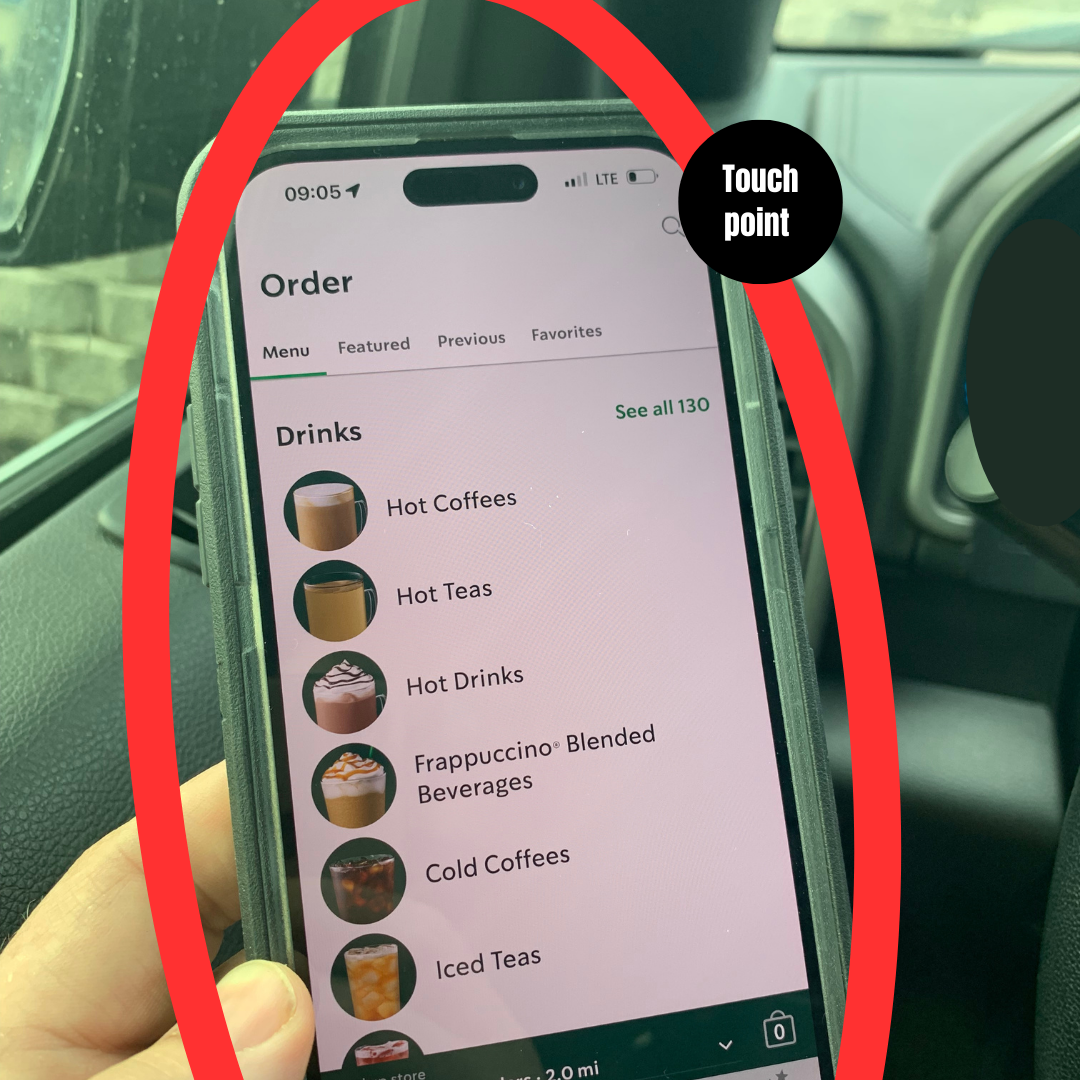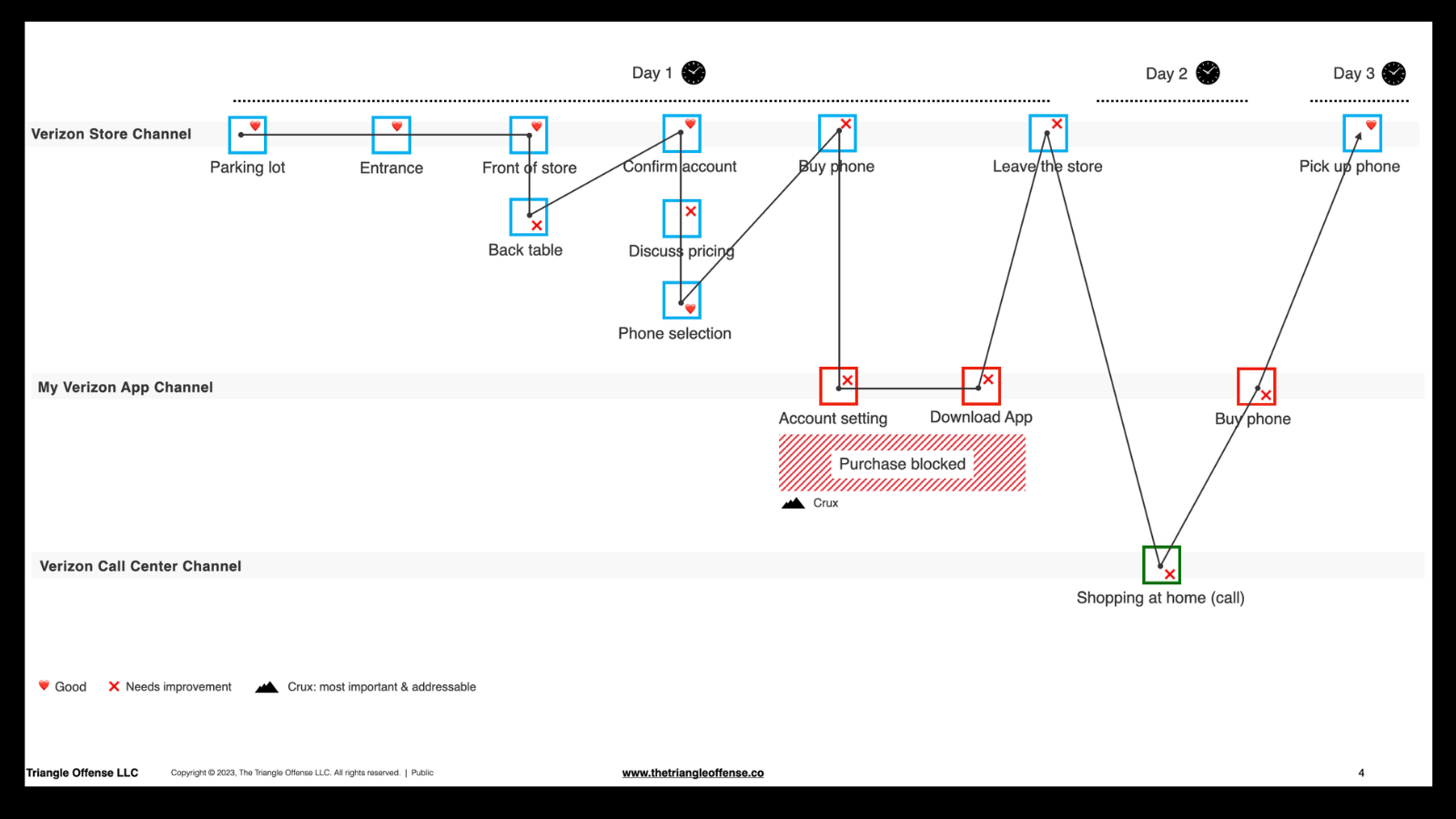What is a Touchpoint in a Journey Map
Dive into the intriguing world of journey mapping and understand how 'touchpoints' shape customer experiences. From a simple tire change appointment to adding a phone to a family plan, these everyday interactions reveal the powerful impact of well-designed touchpoints.

What are Touchpoints?
Different Types of Touchpoints
Think of all the different touchpoints you interact with when you go to pick up a coffee at Starbucks. Now, imagine the customer having to move through your experience. Is it effortless, or is it difficult? The touchpoints concept is among the more straightforward concepts to understand in journey mapping because it involves physical and structural objects customers can touch and with which they can interact.






Starbucks touchpoint inventory when completing the task of picking up my pre-ordered coffee.
CX Versus PX Touchpoints
Journey mapping doesn’t address the difference between a customer experience (CX) touchpoint and a product experience (PX) touchpoint a customer might interact with in the same customer experience. Based on my experience, you don't want to separate the touchpoints into CX versus PX. Instead, you want to address the gaps in a customer experience from a holistic perspective, which requires you to group them all together.
However, if you’re building a journey map have customers interacting with a digital product in a broader customer experience, I would place (PX) for the product in parenthesis each time a customer interacts with a product and completes user tasks. Different teams work on improving touchpoints, so for those teams, calling out different interaction touchpoint types is useful.

Why are Touchpoints Important in Journey Mapping?
Journey maps need to display touchpoints and business teams need to understand them for two main reasons:
Reason #1
Customers usually have a specific task to complete when they’re interacting with a business. We call these customer scenarios.
- Customer Scenario: Customers engage your business in a specific scenario (task) and work to complete their goal. As the customer moves through those moments, they engage with touchpoints throughout your customer experience. You’ll want to understand how effectively customers can complete their task, and the customers will provide you with feedback around their touchpoints.
Reason #2
You may want to correct key moments because customers have voiced dissatisfaction with certain moments in an experience and require improvement.
- Improve specific parts of the experience: The business team can isolate the customer moments that require an investment by reviewing all the touchpoints that support that moment.
A Personal Experience Showcasing Touchpoints
Several weeks ago, on a quiet weekday afternoon, I visited my local Verizon (VZ) store to add a phone to my family plan. I thought this would be a quick in-and-out visit, but before I knew it, I found myself walking back to my car empty-handed. The unplanned detour transformed this everyday experience into a drawn-out, overcomplicated, unnecessary experience that took days instead of minutes and could have been prevented entirely.
Walk Through the Verizon Touchpoints 👇
Verizon Experience Interaction Map
My Verizon experience consisted of three channels: the store, the app, and the call center. (Read up on channels in this post.) I interacted with many touchpoints throughout my three-day ordeal before I finally picked up the phone at the Verizon store.

My Visit to PointS Inspired Me To Write This Post
I recently visited Point S Tire's local shop and had my studded tires swapped out for my summer tires. Like clockwork, I go to the car shop annually to kick-start spring in Montana.

As I waited with other customers for my appointment to wrap up, I broke down the experience I was having with this appointment and the business in which I was sitting in my mind. I went through all the steps that brought me to my seat while the mechanic was working on my car.

I had a lot of different interactions with the Point S tire shop and its staff.
- I parked the car in their lot.
- The staff greeted me as I walked into the shop.
- I identified myself and handed them my keys.
- I had a brief conversation with them about the appointment length.
These are only a few interactions from that morning, but they’re all touchpoints, and those touchpoints combined into different moments and became my experience. In the end, the experience helped me meet my goal, which was to get my tires changed on time so I could resume my day.
Touchpoints power the customer through your business's customer experience. If handled well, they can create powerful, positive customer experiences that will bring customers back year after year (or day after day, depending on what goods and services you provide).
Journey Maps
Since I’m talking about touchpoints within the context of journey maps, understanding the nuances of journey mapping is vital. Journey maps are valuable tools that help you visualize and analyze every touchpoint between a customer and your business.
For those readers who may not be entirely up-to-date on this topic or who need a quick refresher, I encourage you to check out my introductory post about journey mapping and why it’s essential for a business. This post offers a comprehensive overview of the journey mapping process, presents standard journey map elements, and explains why they’re paramount to a successful customer experience strategy.
Summary
The number of touchpoints a business generates in a customer experience can be overwhelming. So, when you’re tasked with improving the customer experience, first ask, “What business problem are we tasked with solving?” Then, your next step is to determine which customer scenarios are linked to that business problem.
Once you know these things, you can start to assess the experience through a scenario, its related tasks, and the moments and touchpoints that support the customer in that task. Touchpoints help paint a picture of customer scenarios and their related tasks, which enables you to target a key moment for improvement.
Written by Leo Vroegindewey, B2B CX Consultant
Get in touch to improve your customer experience and increase sales. Let's talk about how I can help your business grow. Email me.